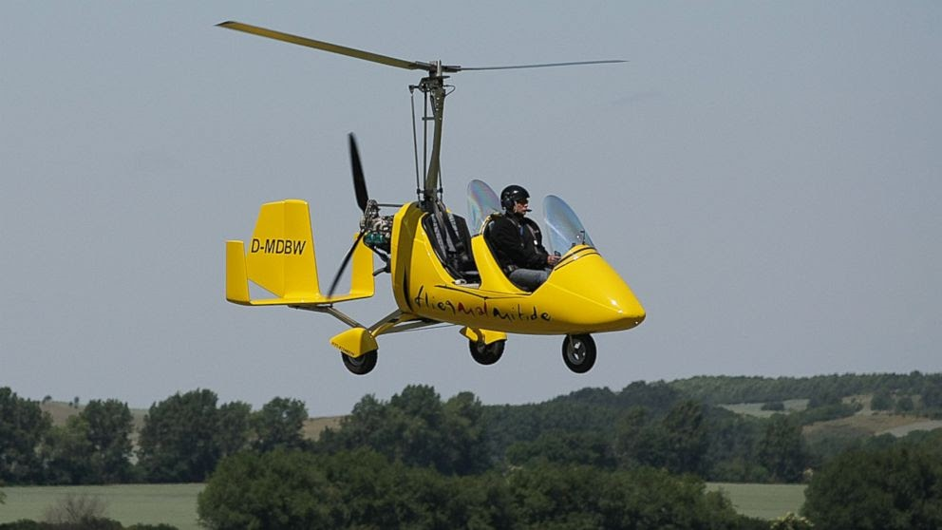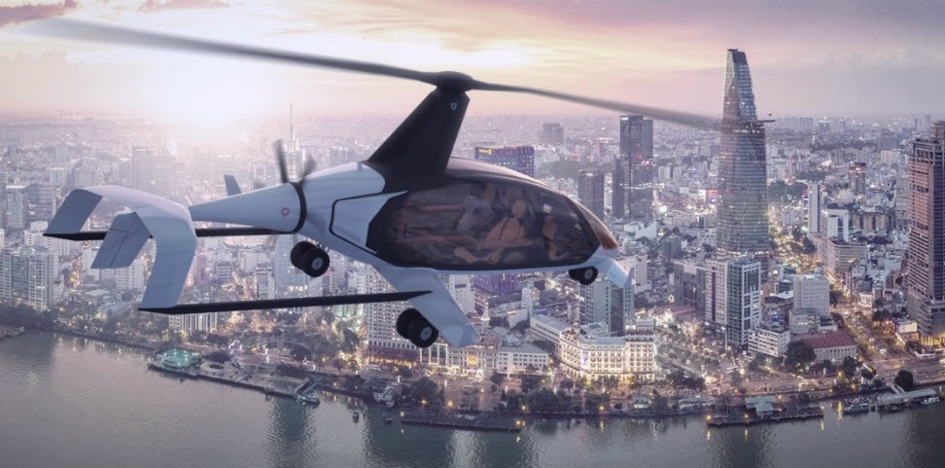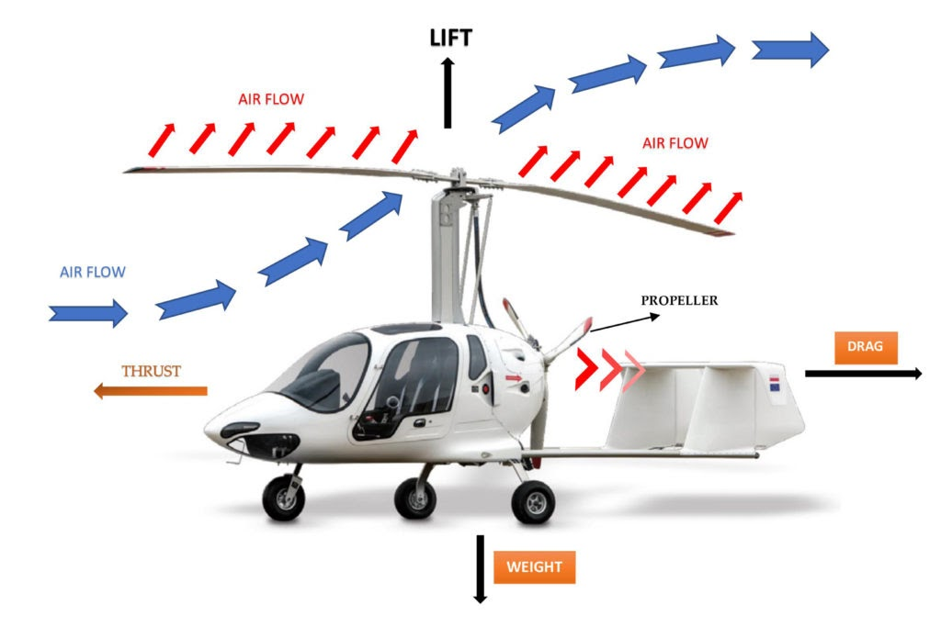Gyrocopter Training: Get Your Rotors Running
Have you ever wanted to fly to work instead of walking or taking an Uber? Well, gyrocopters might prove to be the most readily adaptable to that task, given its simplicity and known safety characteristics. Just imagine your car had wings to fly over the morning routine of swearing in the traffic. I bet it sounds beautiful.
The gyrocopter, also known as gyroplane, autogyro or rotaplane, is a hybrid between a helicopter and an airplane, thus detains very interesting flight characteristics. It’s certainly not a matter of hocus-pocus, but instead a phenomenon called autorotation. Gyroplanes can fly fast and land on a very short distance. No longer just a fun toy for hobbyists, they are poised to transition into a mainstream mode of air transportation. They can fly you around, even more so, you can fly with them around! Find out how simple that is.
Is It Easy to Fly a Gyrocopter?
Gyrocopters tend to be easier to fly than any other fixed wing aircraft. They have only three flight controls: control stick (cyclic), rudder pedals, and a throttle; making it perfect for beginners who have never flown before. Also, they don’t require as much space to be able to take off or land as aeroplanes or helicopters do. Likewise, the cost is much lower which makes this type of flight a lot more accessible than helicopter flying. That explains the growth in popularity, especially for personal use.
How Do You Train to be a Gyrocopter Pilot?
Nowadays, many independent gyroplane schools offer training. The learning curve to become a gyrocopter pilot is very is very similar to Private Pilot, Light Sport or Helicopter pilot training, and requires a significant amount of time. Gyrocopter pilot training normally takes around 30-40 hours. Hence, at least 15 hours under dual instruction and 10 hours of solo flying under the supervision of a qualified instructor. The other 15 hours can be either dual or solo, as required.
These hours are reduced if you already have another type of aircraft license, like a Microlight or Fixed Wing. However, it depends on the gyrocopter school and the individuals, as everyone learns at a different pace.
Once the training course is finished, you have to go through a theory test as well as a practical assessment, known as the General Flying Test. This consists of a series of manoeuvres and procedures under the supervision of an examiner. You should ideally expect it to take about 6 months in total to finish the gyroplane school.
Do You Need a Pilot Certificate (License) to Fly a Gyrocopter?
Yes. There is a specific gyrocopter licence needed – the PPL(G) or Private Pilots Licence for Gyroplanes. But, you do not need a medical to fly gyroplanes!
Usually all gyrocopter licences are issued by the Civil Aviation Authority (CAA) upon the successful completion of the CAA approved training course, a General Flying Test (called a GFT) and a number of written and oral ground school exams.
However, you must comply with airspace restrictions and all FAA (Federal Aviation Administration) regulations covering your geographical area.

Picture 1: Gyrocopter training lasts for 40 hours.
What Makes Gyrocopter the Safest Method of Flying?
Gyros may have the most complex image problem in the aviation, as the opinions about gyrocopter safety are polarized. Gyro pilots unanimously believe that their aircraft are inherently safe and easy to fly, whilst some aviators disagree and describe them as dangerous.
The 1st generation gyros actually were dangerous. A major concern of gyroplane manufacturers and regulators early on was the lack of specific training of those who build, buy and fly gyroplanes. At present, the FAA requires that operators have a sport pilot certificate to operate a gyroplane.
Read more about the gyroplane history in our article!
Therefore, the modern gyrocopter is known to be one of the world’s safest aircrafts. The new European designed gyros have a large horizontal stabilizer, center line thrust and a heavily loaded rotor system which has virtually eliminated the previous issues. The refined design, along with the formal training being offered by certified flight instructors, ensure the gyrocopter safety.
Gyrocopters Cannot Stall (Most Common Reason of Airplane Crashes)
The major advantage of gyros over airplanes and helicopters, is safety in the event of an engine failure. In the regular airplane, when the engine falls, the pilot must try to glide the airplane into a landing. Thus, they must search for an area large enough to land the airplane before it crashes. Pilots do train for this, but dead stick landings require more skill, and an airplane still needs a runway to land.
In contrast, the procedure for landing an autogyro after engine failure is the same for landing it under ordinary circumstances. Gyroplanes use the phenomenon called autorotation (self-propelling rotors) to stay in the air. In other words, the lifting force is provided by a non-powered free rotating wing or blade. That means, even if the air stops flowing, lift power isn’t lost.

Picture 2: Gyrocopters are among the safest rotorcrafts
Due to its unique ability, even if the engine failure occurs, gyros do not stall. The rotor starts slowing down, but keeps spinning, and therefore creating lift power. That allows the aircraft to descend gently – not just fall abruptly. In fact, as long as there is wind coming through the rotor blades, they will keep on spinning fast enough to fly and land you safely.

Picture 3: Gyrocopter has a rotor that turns because of the passage of air through the rotor from below.
Can You Take Cross-Country Flights in a Gyroplane?
Yes! Just like with airplanes, you can enjoy exploring new scenery and visiting new airports. However, some restrictions may affect where you can fly a gyroplane. In other words, you must comply with airspace restrictions and regulations covering certain geographical areas.
Gyroplanes can travel at over 160 km/h, and have enough fuel for at least 3 hours. They are designed to cope with the most diverse demands and weather conditions. Thanks to the interchangeable open and closed canopies, any panorama can be enjoyed to the max. So, if you just want to go out to the airport and play for a couple hours, or travel across the country, these gyros are up to it.
Take a Plunge and Gain the Certificate to Fly!
Gyrocopters really are a fascinating piece of aviation history and engineering. They’re a niche product, but a fun one to fly. It’s no wonder that they’ve developed such a dedicated following of enthusiasts! In many countries, there are more gyroplanes being certified than fixed wing aircraft. We look forward to exploring the world of gyroplanes and hope you’ll stick around for the ride.
What We Do
